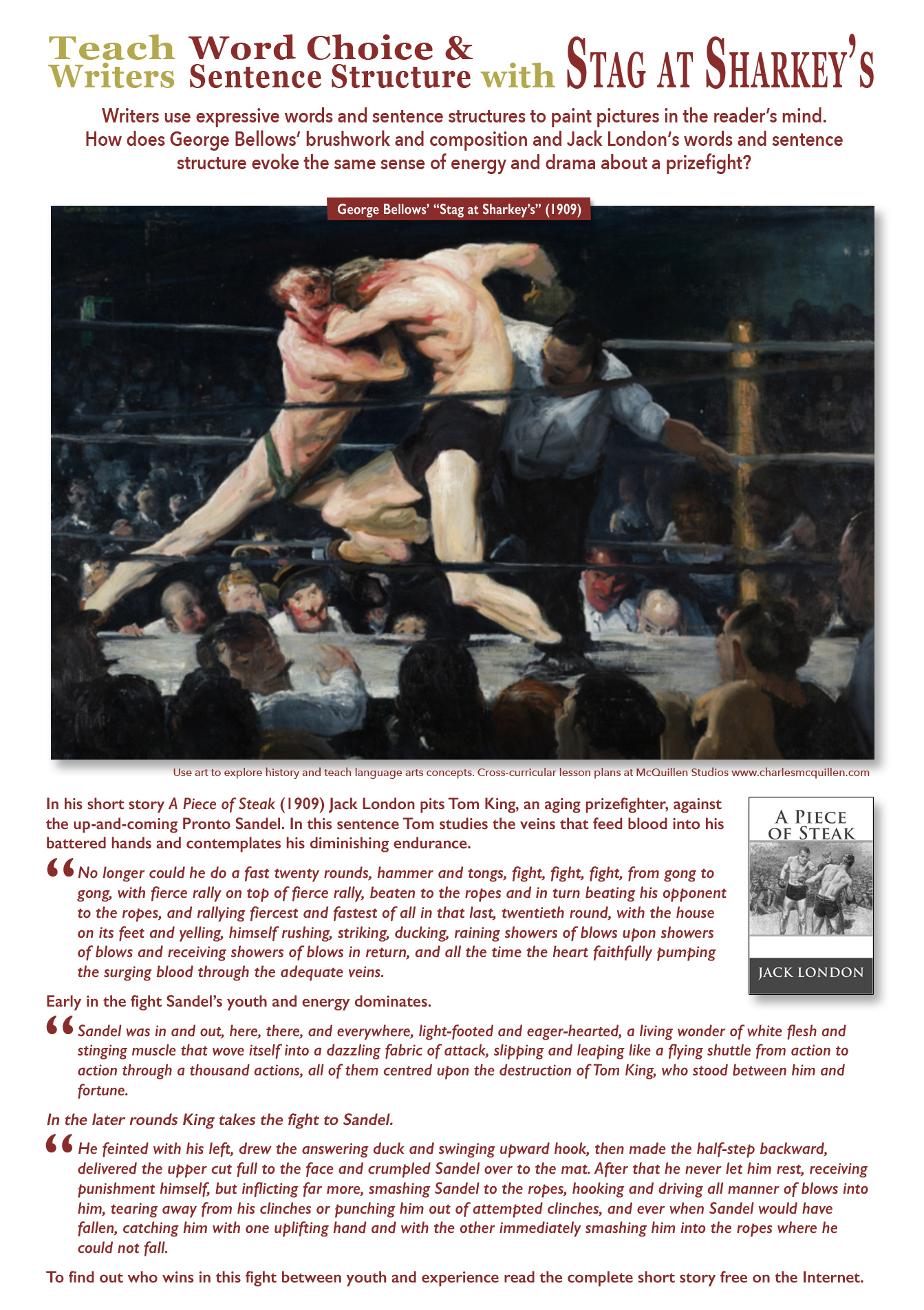George Bellows’ Stag at Sharkey’s offers mentor art for teaching students expressive word choice and sentence structure.
Mentor texts have long been used to model writing techniques. Mentor art can likewise be used to inspire, teach, and refine student writing. Mentor art has the added benefit of addressing diverse learning styles and providing visual support to language learners. Consider introducing expressive word choice and sentence structure to your students with George Bellows’ Stag at Sharkey’s.
It is beneficial to let students experience a work of art on its and their own terms before using it as mentor art. This link offers teaching moves and language for introducing students to George Bellows’ Stag at Sharkey’s. This image of Stag at Sharkey’s from the Cleveland Museum of Art lets you magnify the painting to see exquisite detail. Thank you Cleveland Museum of Art! This video models how this painting can be used to cultivate cross-curricular learning.
#1 How does George Bellows’ brushwork and composition accentuate the energy and drama of the fight?
Turn, Talk, and Report Back (Possible answers: Bellows applies the paint in thick slashing gestural brush strokes that create a visual energy and rhythm. The gesture echoes the action and ferocity the fighters. This accentuates the muscular twisting and torquing of their bodies The thickness of the paint adds dimensionality to the muscles. These aren’t dainty brush strokes, its like Bellows applied the pigment with his fists. Rapid blurry brushstrokes throughout the canvas evoke energy and motion. He applies the paint wet, causing it to blend and streak like the blood, sweat, and saliva that drips off the fighters. The roiling immoral crowd is rendered with crude smudges and smears. Deep shadows heighten the sense of drama. The black background silhouettes the fighters, highlighting them and pushing them closer to the viewer. A stable triangular composition frames the fighters and organizes the scene’s dynamic energy. Note how the left fighters leg and back create one side of the triangle, the back of the fighter on the right and the referee’s arm create the other side of the triangle, and the canvas and spectators serve as the base. Smaller triangles, such as the fighter’s legs, organize and accentuate the fighters’ features.)
 Project the image above and read the excerpts from Jack London’s A Piece of Steak. Dramatic readings may help students hear and feel the physicality of the language. Click on the image to expand. Download the pdf below.
Project the image above and read the excerpts from Jack London’s A Piece of Steak. Dramatic readings may help students hear and feel the physicality of the language. Click on the image to expand. Download the pdf below.
#2 How do Jack London’s words and sentence structure evoke the same feelings and images as Bellows’ brushwork and composition?
Turn, Talk, and Report Back (Possible answers: London’s verbs are as action-packed and aggressive as Bellows’ brushstrokes—yelling, rushing, striking, ducking, leaping, hooking, driving, smashing, tearing, inflicting, punching, and smashing. In addition to the verbs, the regular use of gerunds as descriptors (using ing to make verbs other parts of speech) accentuates the auditory rhythm and crams more action into a sentence—stinging muscle, dazzling fabric, flying shuttle, surging blood, living wonder, uplifting hand. Like the brushstrokes, key words and phrases are repeated over and over creating a rhythm that pounds away at the page—“fierce rally on top of fierce rally,” “showers of blows upon showers of blows and receiving showers of blows,” and “from action to action through a thousand actions.” This rhythm and sense of motion is further accentuated by the short clipped relative clauses that are strung together with an exhaustive series of commas. The sentences are long and leave the reader panting like the fighters themselves. The motion described isn’t relaxed movements, rather it is violent, full of muscular strain and torque. Like Bellows’ painting, the surroundings and spectators are nondescript with the focus almost exclusively on the fighters’ efforts. London evokes Sandel’s speed and elusiveness, not only with the words chosen, but also with their pacing, “Sandel was in and out, here, there, and everywhere…” His detailed step-by-step description of King evokes the experienced fighter’s economical and calculating approach to the fight. The focus in both works of art is a startlingly close view of the fighters and highlights prizefighting’s harsh physical and emotional toll.)
#3 How might this comparison between George Bellows’ brushwork and composition and Jack London’s word choice and sentence structure inform your writing?
(Answers will vary though students may note that to realize the full expressive potential of paint and words, that artists must also consider how they are applied and structured. Patterns are important in bringing words/colors to life and cohesion to a composition.)
How would you use George Bellows’ Stag at Sharkey’s to teach expressive word choice or sentence structure? Extend the discussion with your comments below.
Bellows-London-handout
Comments are closed, but trackbacks and pingbacks are open.